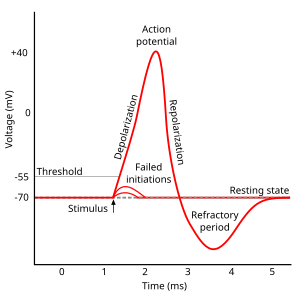2017-02-12 11:54:37
Ease on down, ease on down
Propagation is the way…
Today's Topics
- Driving force and equilibrium potential
- Action potential propagation
Driving force and equilibrium potential
- "Driving Force" on a given ion depends on its equilibrium potential.
- Driving force larger if membrane potential far from equilibrium potential for ion.
- Equilibrium potential
- Voltage that keeps current (inside/outside) concentrations the same
- Voltage membrane potential will approach if only that ion flows
Equilibrium potentials calculated under typical conditions
| Ion | [inside] | [outside] | Voltage |
|---|---|---|---|
| K+ | ~150 mM | ~4 mM | ~ -90 mV |
| Na+ | ~10 mM | ~140 mM | ~ +55-60 mV |
| Cl- | ~10 mM | ~110 mM | - 65-80 mV |
Action potential and driving forces
Rising phase
- Membrane permeability to Na+ increases
- Na+ inflow
- Na+ driving force (toward +55 mV) dominant
Falling phase
- High Na+ permeability ends
- Permeability to K+ increases
- K+ outflow
- K+ driving force (toward -90 mV) dominant
AP propagation
- Propagation
- move down axon, away from soma, toward axon terminals.
- Unmyelinated axon
- Each segment "excites" the next
AP propagation is like
AP propagation
- Myelinated axon
- AP "jumps" between Nodes of Ranvier, saltatory conduction
- Nodes of Ranvier == unmyelinated sections of axon
- voltage-gated Na+, K+ channels exposed
- Current flows through myelinated segments
Question
- Why does AP flow in one direction, away from soma?
- Soma does not have (many) voltage-gated Na+ channels.
- Soma is not myelinated.
- Refractory periods mean polarization only in one direction.
Question
- Why does AP flow in one direction, away from soma?
- Soma does not have (many) voltage-gated Na+ channels.
- Soma is not myelinated.
- Refractory periods mean polarization only in one direction.
Conduction velocities
Information processing
- AP amplitudes don't vary (much)
- All or none
- AP frequency and timing vary
- Rate vs. timing codes

